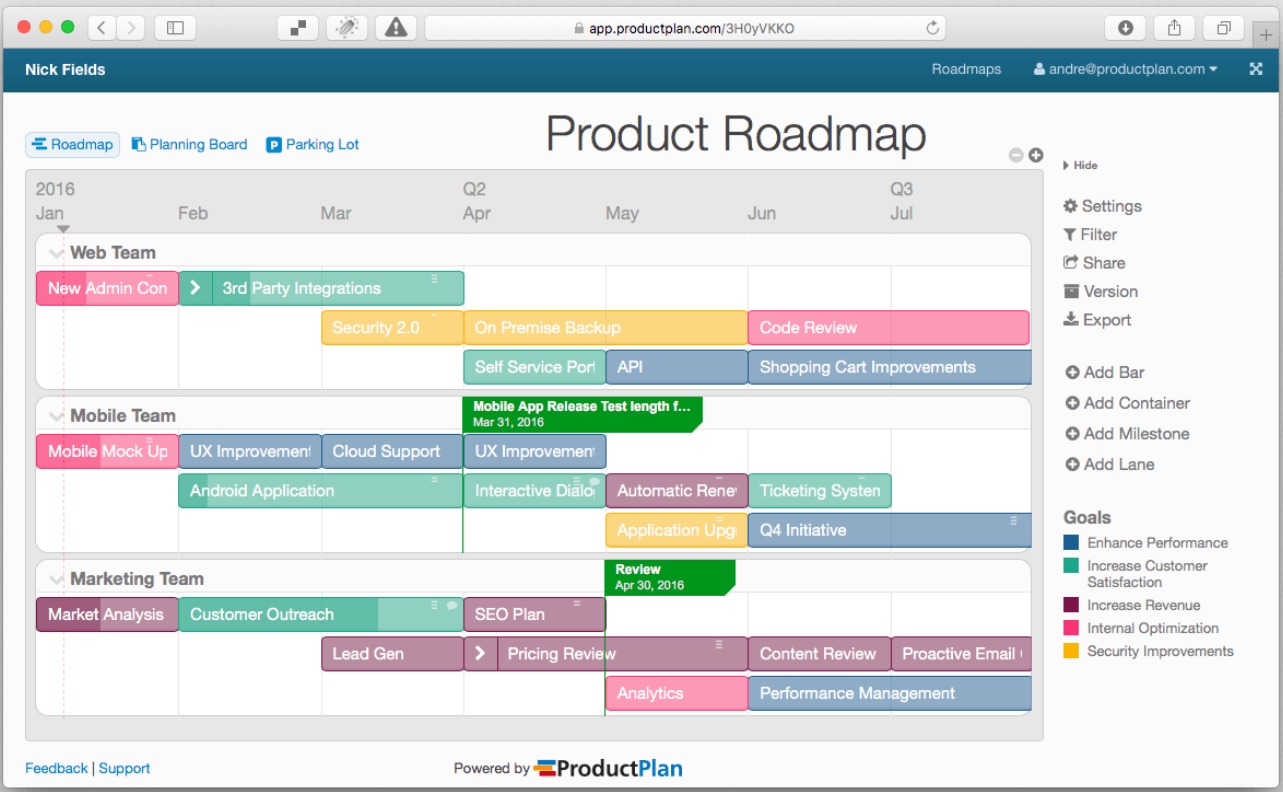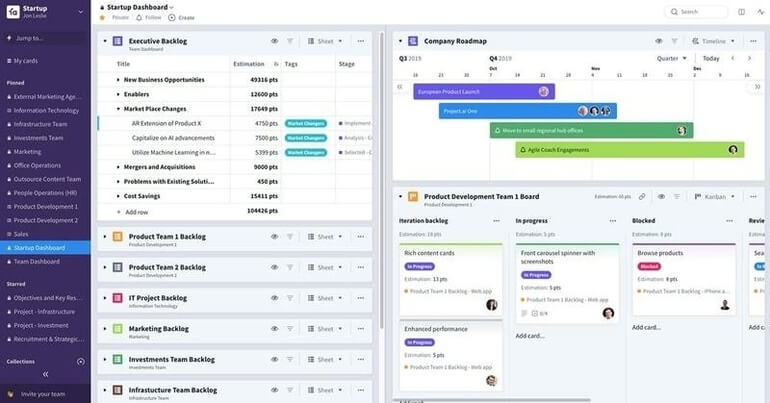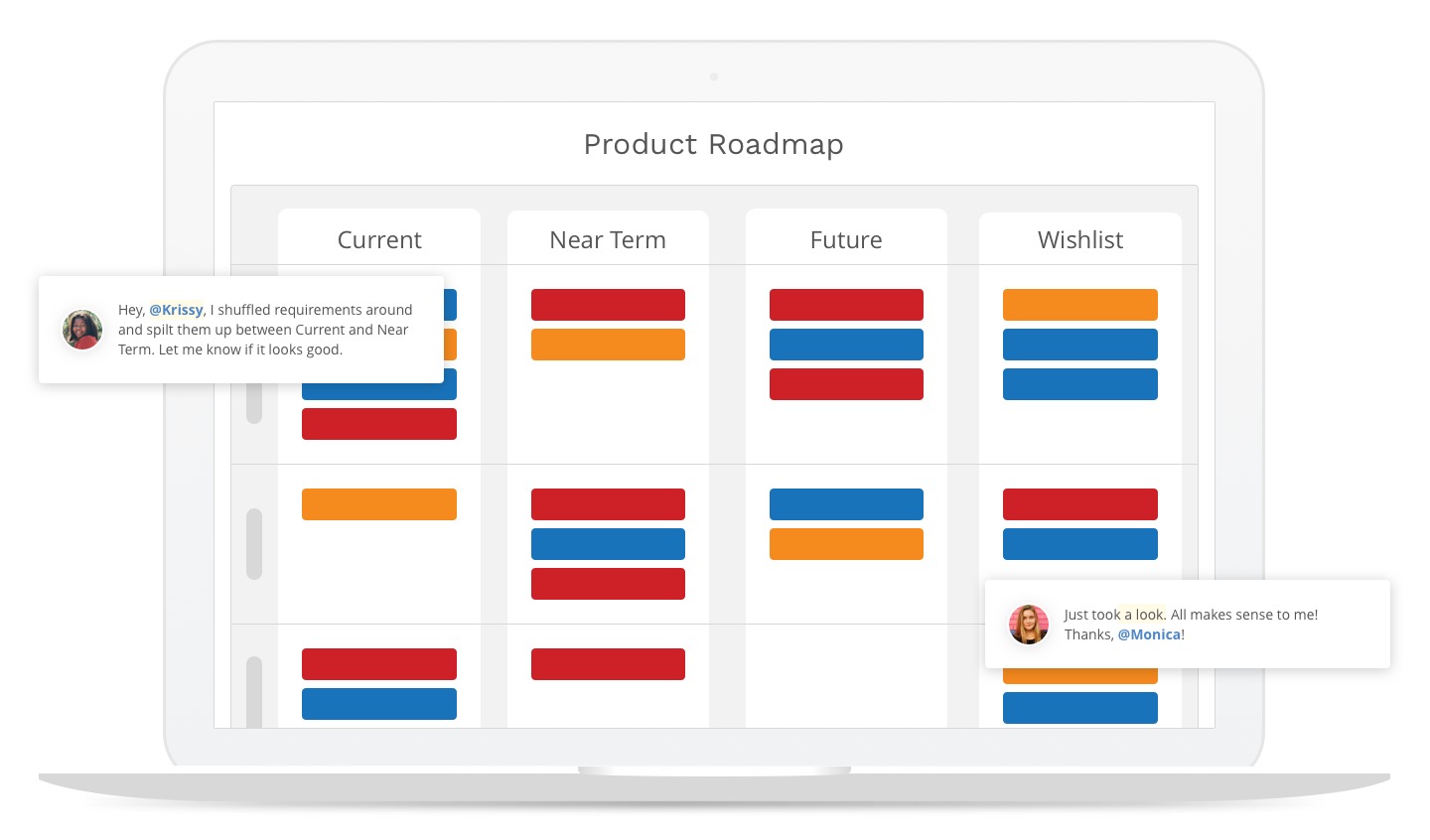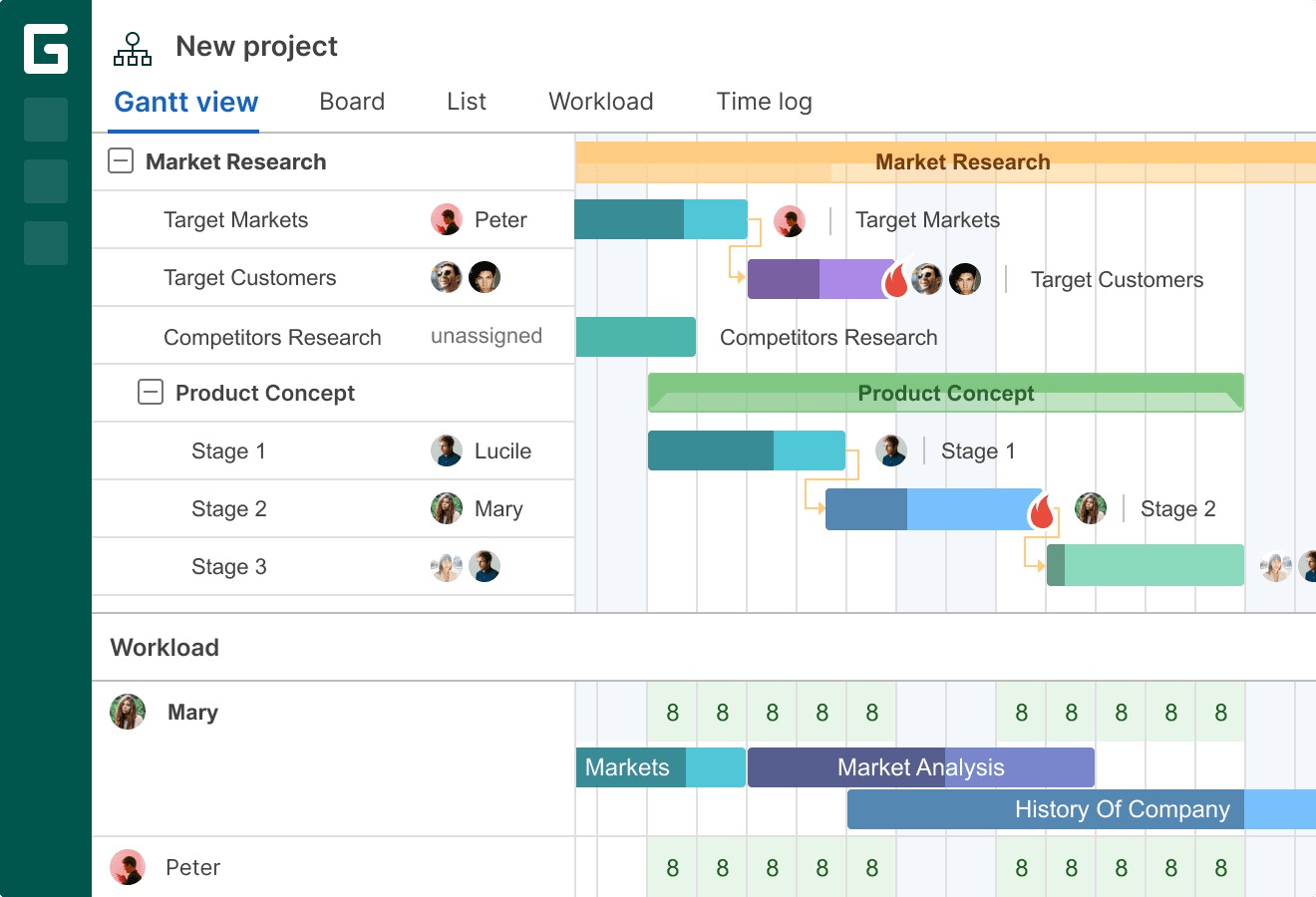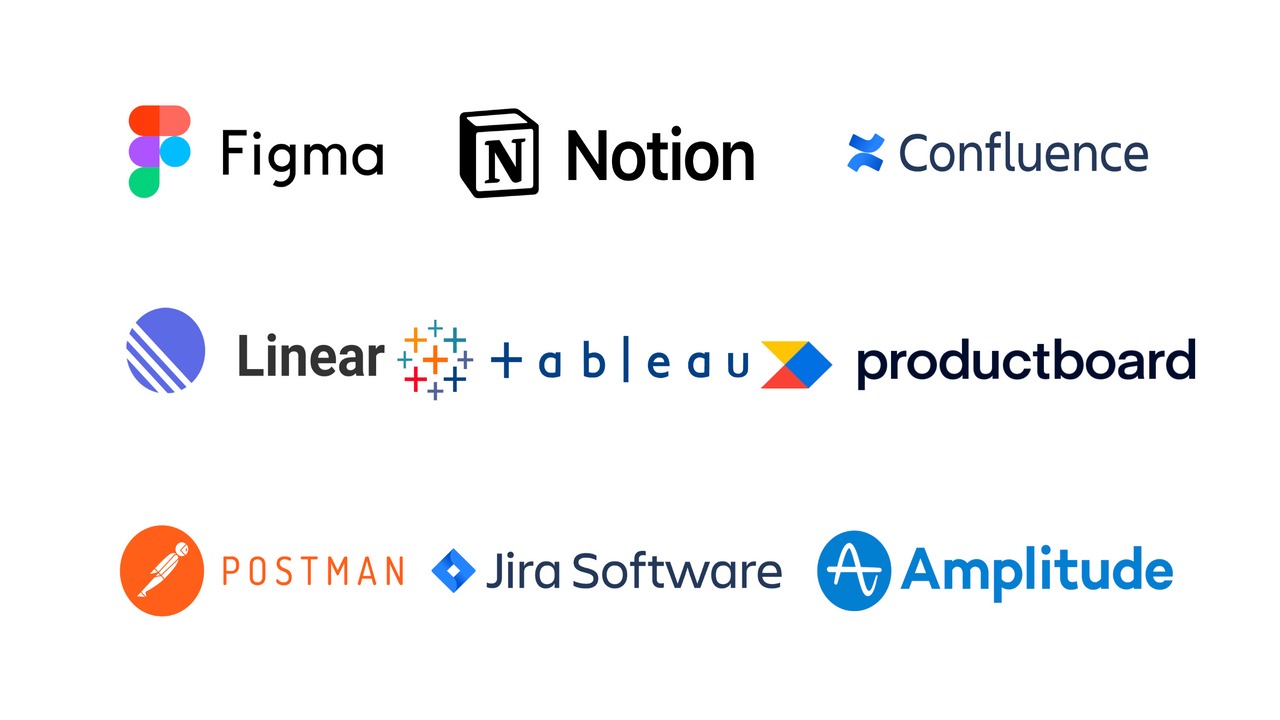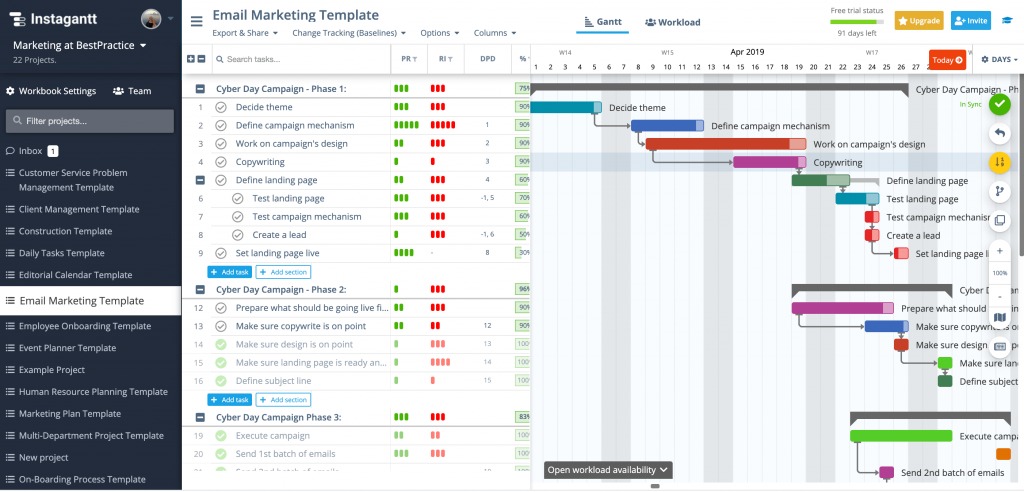
With the use of product management software, you may handle daily tasks while maintaining an overall perspective. Whether working in-house or remotely, they make sure that everyone is on the same page and promote cooperation throughout the product development process.
Teams can manage the whole product life cycle from a single, convenient interface with the aid of the best product management softwares, which provides all-in-one ease. From product conception to market delivery, these tools support you. This covers user behavior analysis, strategy, planning and sharing, prototyping, onboarding customer support, and productivity.
However, there is no one-size-fits-all approach to product management, so what works very well for one person may not work for you. In this article, we will discuss the best product management softwares that you can use.
What Is Product Management Software?
Product management software helps companies create and enhance their software offerings more rapidly and effectively. Product managers and their teams may utilize these solutions to gather fresh concepts and user input, assess the success of their products, and carry out targeted strategies for developing and enhancing features and products.
Although product managers and product teams are the primary users of these technologies, marketing and sales departments may also benefit from the improved openness and insight they offer into product development.
Many capabilities are available in best product management softwares to help plan and carry out well-informed product plans. Roadmap elements enable the continual tracking of a product team's progress and the adjusting of timeframes by breaking out activities from conception to product launch.
Product teams can backlog the most critical work to be completed in a later sprint or prioritize them using user feedback management features and analytics. Product management solutions also give development teams access to tools for managing their resources, their product portfolio, and agile processes like user testing, sprint planning, and bug tracking.
Collaboration tools like chat rooms and comment threads are sometimes included in product management software. Although project management software's road planning functions and those of best product management softwares have certain similarities, the latter's unique characteristics, namely, the integration of user feedback management and product analytics, improve software product development cycles.
Understanding The Role Of A Product Manager
Product managers play a vital role in developing and improving products. They make critical decisions based on what customers want and what makes sense for the business. This role involves teamwork and many different responsibilities.
Setting Clear Strategies
Product managers define a vision and plan for a product. They explain why certain features or changes are needed and connect them to the product's goals. They also create a roadmap that shows what will be done and when.
- This helps everyone understand the reasons behind product decisions.
- It ensures that the team focuses on the most important tasks.
- It keeps the product on the right track.
Evaluating Ideas
Generating good ideas is crucial for successful products. Product managers collect, develop, and choose the best ideas that will benefit customers. They also make sure that these ideas are included in the product planning process.
- They keep everyone informed about the status of these ideas.
- Feedback from customers and team members is essential in this process.
- Only the most promising ideas move forward.
Prioritizing Features
Product managers decide what features a product should have and how it should work. They work closely with the engineering team to ensure everyone understands the technical details. They prioritize features based on their value to customers and the business.
- This involves making tough decisions when resources are limited.
- It focuses on delivering the most value with the least effort.
- It considers the long-term benefits of each feature.
Defining Releases
Product managers turn their product strategy into a plan for what will be built and when it will be released. They manage the entire release process, which involves coordinating various teams like marketing, sales, and customer support.
- They bridge the gap between different parts of the company.
- They make sure everything is ready for the product to go to market.
- This applies to various development methods used by the engineering team.
Creating Strategic Roadmaps
Product managers use product roadmaps to communicate their plans. These roadmaps show how the product will achieve its goals. They can vary in detail depending on the audience, with executives needing high-level plans and engineers needing specifics.
- Roadmaps help everyone understand what to expect in the future.
- They keep the team aligned and focused on the big picture.
- Different stakeholders require different types of roadmaps.
Analyzing Progress
Great product managers pay close attention to results, both for customers and the business. They need to know how well the product is doing and if it's meeting its goals.
- They use data to track progress and make informed decisions.
- This helps in identifying areas that need improvement.
- It ensures the product continues to evolve and meet customer needs.
Factors To Consider When Choosing Best Product Management Softwares
When choosing a product management software, several factors should be considered to ensure the right fit for the organization. These factors include:
Company Size And Budget
The cost of product management software varies based on factors like the vendor, features, and user. Larger companies may require more robust and scalable solutions, while smaller companies may have budget constraints.
Project Complexity And Scale
The complexity and scale of the projects being managed will influence the type of software needed. For instance, software that serves product managers and their teams makes it easier to coordinate with each other when needed.
Integration Requirements
It's important to consider the integration needs of the software with existing tools and systems within the organization. This includes tools for data analytics, wireframing, market surveys, task management, and team messaging and collaboration.
User Training And Support
Evaluate the user interface, navigation, and overall user experience of the software. Choose software with a clean and intuitive interface, customizable workflows, and easy collaboration features. Additionally, consider the vendor’s implementation support and services to guarantee a seamless transition.
Future Growth And Scalability
The software should be able to accommodate the organization's future growth and scalability needs. This involves ensuring that the software can adapt to the changing needs of the organization and support its long-term product management goals.
Top Best Product Management Software
Airtable
With the help of the linked platform Airtable, customers may develop apps for all of their particular use cases. Goal tracking, sprint management, and road mapping are common uses for Airtable.
Using a common roadmap, Airtable allows you to represent the relationships between upstream UX research and downstream marketing material. Your product roadmap and your OKRs or strategic goals might be connected. On high-level projects, collaboration is also facilitated when all teams utilize the same technology.
Because Airtable is so customizable, you can include specific information like product codes and customer reviews. Airtable also allows you to break down big goals into smaller, more achievable tasks, which aids in managing the whole product development lifecycle.
- Unified Data Updates- Airtable ensures data consistency across tables, facilitating easy access to related information.
- Versatile Data Handling - Handle various product-related data efficiently within a single platform.
- Customized Views - Create tailored data views, optimizing the interface for your specific needs.
- User-Centric Design - Craft personalized interfaces to focus team members on relevant information and actionable tasks.
Productboard
A product management application called Productboard is well-suited for roadmapping and offering consolidated input. Teams may use the platform to construct personalized roadmaps that monitor and visualize product development objectives from conception to launch. Product managers now have an easy way to optimize and streamline their development processes using Productboard.
- Custom Views- Easily customize your product strategy with roadmap, list, and timeline views.
- Feedback Organization- Gather and prioritize customer feedback from various sources, streamlining your roadmap planning.
- Feature Prioritization- Assign scores to features based on impact, alignment, and effort, making it more straightforward for product managers to prioritize their roadmap.
Productplan
A road mapping point solution is ProductPlan. By just dragging and dropping objects, roadmaps can be swiftly created, and objectives and tasks may be prioritized. To help team members collaborate and stay on the same page, ProductPlan also provides real-time editing, comments, and notifications. Smaller product teams, who may benefit from a pre-set framework to get started quickly and don't require sophisticated product management tools, are drawn to it.
- Custom Views- Create personalized roadmaps and share them selectively.
- Unlimited Viewers- Provide free access to stakeholders for shared roadmaps.
- Planning Board - Effectively prioritize and manage tasks, differentiating between planned and unplanned work.
Monday.Com
Monday.com is a cloud-based project management application intended to facilitate real-time teamwork, job management, and progress tracking. The platform has a number of capabilities, such as customizable high-level dashboards, dependencies, and deadlines that make it helpful for monitoring goals. For teams that simply need a little customization, Monday.com could be the best option.
- Multiple views- Monday.com offers diverse visualization options, including Gantt charts and timeline views.
- Customizable templates- Access goal-tracking templates for various needs (e.g., quarterly objectives, OKRs) and tailor them to your requirements.
- Real-time tracking- Monitor KPIs and baseline assessments across multiple projects through dynamic dashboards with real-time metric updates.
Craft.Io
Craft.io is a comprehensive product management platform designed for product managers to plan and manage products with confidence. It offers an end-to-end product management solution with features such as feedback collection, feature definition, prioritization, capacity planning, roadmap execution, and more.
Craft.io aims to help product teams become better at strategizing, planning, and communicating the product story as they work, and thousands of product teams trust it. The platform offers a free plan with unlimited contributors, as well as paid plans with additional features such as development tool integration, workflow management, and enterprise-grade security and support.
Craft.io allows users to build and share their roadmap strategy, manage personas, and define and manage product objectives and goals. It is designed to create a single source of product truth to align all stakeholders, track progress, and deliver successful products, enabling efficient communication, informed decisions, and collaborative teamwork
- Product Strategy and Vision- Craft.io provides tools for defining and shaping your product strategy and vision.
- Product Portfolio Management - It allows you to manage and oversee multiple products within your portfolio efficiently.
- Feedback and Backlog Management - Craft.io includes features for collecting and organizing user feedback and managing your product backlog.
- Integration and Planning - The software offers integrations with various tools, including project management, collaboration, communication, software development, and design tools, to streamline your product management processes.
Aha!
Aha! is a cloud-based software company that provides product development software for organizations to set strategies, ideate, plan, showcase, build, and launch new products and enhancements.
Aha!, a U.S. software company, reports that the median salary for product managers in San Francisco is $129,000.
The Aha! suite of products includes Aha! Roadmaps, Aha! Ideas, Aha! Notebooks, Aha! Develop, and Aha! Academy, which enables teams to bring a raw concept to a finished product within a unified product development platform. The software provides functionality for users to link strategic goals and initiatives to their work, create visual roadmaps of upcoming plans, and track key business objectives through product management and development.
Aha! is used by more than 700,000 product builders from companies of all sizes. It is designed for product teams, including product managers, engineers, and product development teams, to streamline the process from idea to delivery with a focus on customer value.
The software is used by various companies and industries, such as IT, project management, business operations, and marketing, to manage different phases of product development, from strategy and creativity to road mapping and release management
- Idea Management- Capture and organize customer feedback and ideas to inform product development.
- Roadmapping - Create and manage product roadmaps to visualize and prioritize features and tasks.
- Collaboration with Notebooks - Facilitate collaboration and resource sharing within your team using digital notebooks.
- Integration Ecosystem- Seamlessly integrate with various development, communication, CRM, project management, and knowledge management tools to streamline your workflow.
Jira Software
Jira Software is a project management tool developed by Atlassian, primarily designed to track issues and bugs related to software development. It has evolved to become a powerful tool for managing complex digital product development projects, particularly in the realms of application and Software as a Service (SaaS) development.
Jira's versatility in handling various aspects of project management, from sprint planning to issue tracking, makes it a go-to choice for software developers and Agile teams.
- Agile Project Management- Supports Scrum and Kanban methodologies.
- Customizable Workflows- Offers flexibility in process management.
- Advanced Reporting - Provides insights through detailed reports.
- Integration Capabilities- Seamlessly integrates with various tools.
Prodpad
ProdPad is a comprehensive product management tool designed to support the complete lifecycle of a product. It emphasizes idea management, roadmap planning, and feedback incorporation, making it an ideal solution for product managers who focus on bringing innovative products to market.
ProdPad helps in aligning the product development process with business goals and customer needs, ensuring a well-rounded approach to product management.
- Roadmap Planning- Facilitates visual roadmap creation.
- Idea Management - Organizes and prioritizes product ideas.
- Feedback Loop- Integrates customer feedback into product development.
- Product Portfolio Management - Manages multiple products effectively.
Confluence
Confluence, another product from Atlassian, is designed as a content collaboration tool that helps teams create, share, and collaborate on projects and ideas. It is particularly renowned for its extensive range of templates, which make it easy for teams to document, plan, and track their product development processes.
Confluence serves as a single source of truth for teams, ensuring that everyone stays on the same page throughout the product development cycle.
- Diverse Templates - Provides various templates for different needs.
- Knowledge Sharing- Central hub for documentation and best practices.
- Integration with Jira - Enhances tracking and management when used with Jira.
- Customizable Spaces - Allows creation of project-specific spaces.
Asana
Asana is a highly popular product management software known for its user-friendly interface and versatile project management features. It caters to a wide range of teams and industries, offering tools for task management, team collaboration, and project tracking.
Asana’s focus on simplifying task and project tracking makes it an ideal tool for teams looking to streamline their product management processes and improve team coordination.
- Task and Project Tracking- Provides a clear overview of tasks and progress.
- Customizable Dashboards- Allows the creation of tailored dashboards.
- Team Collaboration- Facilitates effective team communication.
- Integration with Other Tools- Compatible with various other software.
What Are The Pros And Cons Of Using Cloud-Based Product Management Software?
The use of cloud-based product management software offers several advantages and disadvantages, as highlighted in the search results:
Based on recent statistics, it's evident that a mere 40% of the products developed by companies manage to maintain their presence in the market.
Pros
- Cost Savings- Cloud-based solutions can lead to significant cost savings by eliminating the need for full-time IT professionals and reducing infrastructure costs.
- Greater Collaboration- Cloud-based software allows for greater collaboration and communication between teams, as well as simultaneous access to the same data.
- Scalability- Many cloud-based product management tools are scalable, making them suitable for businesses of various sizes.
- Security- Vendors often offer a higher level of security for cloud-based solutions, providing round-the-clock support and secure data storage.
- Convenience- Cloud-based product management software provides an all-in-one interface for managing the entire product lifecycle, encouraging collaboration, and streamlining workflows.
Cons
- Reduced Control and Visibility- Cloud-based solutions may result in reduced control and visibility over the software, which is a concern for some businesses.
- Internet Dependency- Storing data in the cloud requires a consistent internet connection, and downtime can disrupt business operations.
- Less Room for Personalization- Some cloud-based solutions may offer less room for personalization, which can be a limitation for businesses with specific customization needs.
- Long-term Costs - While cloud-based solutions may offer cost savings in the short term, monthly payments can make them more expensive in the long run.
Frequently Asked Questions
Is Jira Good For Product Management?
Project managers utilize Jira, a robust platform, to organize and oversee their product development initiatives.
What Are The 3 Major Areas Of Product Management?
Product management is divided into three main areas: development, planning, and discovery.
What Tool Do Product Managers Use?
Among the many tools a product manager will need to employ are tools for industry analysis. Software for flowcharting and road mapping. Tools for user surveys and analysis.
Conclusion
The best product management softwares offers a comprehensive and flexible solution to manage the entire product lifecycle. These tools enable teams to work collaboratively, streamline workflows, and maintain a clear vision of their product strategy. They incorporate a range of features, including road mapping, feedback management, feature prioritization, and analytics, to ensure that every aspect of product development is covered.
Product managers can leverage these tools to make informed decisions, prioritize tasks, and effectively manage resources. However, the choice of product management software depends on various factors like company size, project complexity, integration requirements, and budget constraints. With options like Airtable, Productboard, Monday.com, and Jira, among others, businesses have a variety of tools to choose from, each with its unique strengths.
Ultimately, the best software is one that aligns with the specific needs and goals of the organization, supporting its growth and facilitating the creation of successful products. As the field of product management evolves, these tools will continue to play a crucial role in helping companies innovate and stay competitive in the marketplace.
